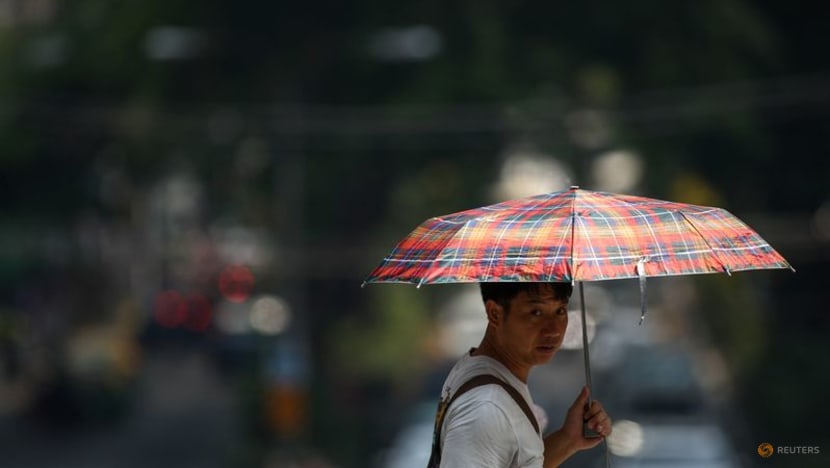Commentary: Southeast Asia’s new imperative to confront brutal heat
Decarbonising the global economy is the only lasting answer to global warming, but meanwhile ASEAN countries must invest in climate proofing and resilience building, says ISEAS-Yusof Ishak Institute’s Dr Vinod Thomas.

SINGAPORE: Southeast Asia has sizzled under record-breaking heat in recent weeks. Temperatures hit 42 degrees Celsius in Bangkok in late April, and 37 degrees Celsius in Singapore on May 13.
There may be little relief in the coming months. The ASEAN Specialised Meteorological Centre on May 29 warned of a higher risk of haze between June and October due to a more intense and prolonged dry season. Singapore’s Inter-Agency Haze Task Force is coordinating action plans and has advised the public to ensure they have sufficient N95 face masks and air purifiers.
The spate of extreme heat raises the stakes of human-caused climate change. Research by the World Weather Attribution Group suggests that the April heatwave affecting swaths of South and Southeast Asia this year was made 30 times more likely because of climate change.
Decarbonising the global economy is the only lasting answer to global warming, but meanwhile countries must invest in climate proofing and resilience building. Nothing short of a multi-pronged response across energy security, food security and public health will suffice.
COOLING AMID RISING ENERGY DEMAND
Southeast Asia symbolises the “super wickedness” of climate change in that short-term responses can worsen the problem over time. Extreme temperatures bring about more demand for air-conditioning and refrigeration, which in turn causes the burning of more fossil fuels for energy.
Vietnam, for instance, is switching off street lights and factory operations at off-peak hours, in anticipation of the ongoing heatwave putting a strain on the national grid.
Plans to implement green cooling solutions need to be stepped up across Southeast Asia. Where urban sprawl has replaced vegetation, heat is trapped by concrete and asphalt in buildings and roads during the day, then released at night, resulting in the urban heat island effect.
As part of the Singapore Green Plan 2030, the country is implementing sustainable cooling solutions, such as distributed district cooling in Tampines. In this more energy-efficient system, chilled water is generated in a central cooling plant, then piped to various buildings through an underground network to provide air conditioning.
Besides such technology, street trees, urban forests and green roofs can help cool urban areas.PROTECTING FOOD AND WATER SUPPLIES FROM HEATWAVES
The most proximate threat from heatwaves lies in their impact on water and food security. Water needs to be stored, distributed and conserved in lean times.
This would mean rainwater harvesting and collection; treatment of used water; and seawater desalination, which have been practised in Singapore.
Heatwaves take a toll on crops and the water supplies they need. New agricultural practices that are not water-intensive, like drip irrigation, must be promoted, while farmers need to be supported in switching to climate-resistant crop varieties. Laws against slash and burn agriculture must be effectively enforced, to cut not only air pollution but also carbon emissions.
Food security can also be aided by reining in wastage. One-third of all food produced worldwide - or 1.3 billion tonnes - is lost or wasted every year, contributing up to one-tenth of global GHG emissions. Up to 50 per cent of cassava losses in Thailand occur during the harvest and post-harvest. Only 10 per cent of perishable food in India have cold storage, causing a 30 per cent loss of fruits and vegetables.
WORKING UNDER RELENTLESS HEAT
With more frequent heatwaves, more outdoor workers across South and Southeast Asia, will have to toil under daily temperatures past 40 degrees Celsius. Government support to protect workers’ health is vital.
Subsidies can be targeted to help farmers plant trees and buy equipment better suited for the extreme weather. Workers in cities and villages can also benefit from early warning systems, better preparedness and community outreach programmes.
Insurance schemes can help transfer some of the risks of severe heat faced by industrial, construction and agricultural workers to insurers. Insurance against natural hazards is minimal in Asia, with just 17 per cent of losses covered.
The soaring temperatures across South and Southeast Asia, the epic floods in Northern Italy, the deadly cold fronts in Northeast Asia last winter are typically labelled as once-in-a-century or once-in-a-decade events, suggesting they are rare acts of nature.
But the reality is that what were once statistically improbable occurrences are now more common because of climate change. It is urgent that the old assumptions are discarded and Southeast Asia act on multiple fronts to avert worst-case scenarios.
Dr Vinod Thomas is Associate Senior Fellow at the ISEAS-Yusof Ishak Institute and author of Risk And Resilience In The Era Of Climate Change.


















